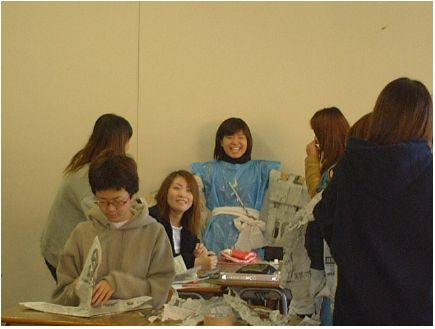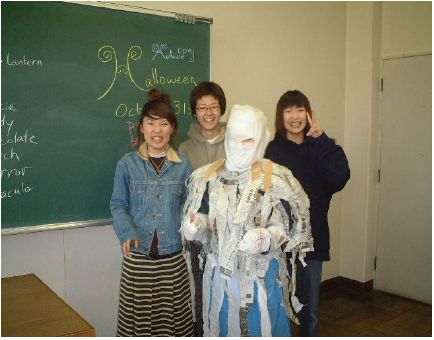
|
 |
|
Teaching Festivals and Holidays
Poster Session, JALT "Waves of the Future" Conference
"Granship", Shizuoka
Saturday November 23, 2002
Halloween Lesson
Intended Learning Outcomes:
- Students will contribute to a vocabulary list of words they associate with the holiday of Halloween
- Students will answer quiz questions about the history and practices of Halloween
- Students will negotiate in groups to construct a costume together using words and phrases appropriate to offering suggestions, negating suggestions, offering alternative suggestions, directing an activity, as well as phatic language during the costume-making period.
- Students will report upon the process of making the costume (step 1, step 2, etc.) and the reason(s) for choosing to make that character.
- Students will write a story about their character as homework following rules of genre for short story writing. These may be shared in the next class.
Resources:
- Blackboard and chalk or white board and white board markers
- Students need pencil and/or pen and paper
- A set of the following for each group of students:
1 plastic garbage bag
1 pair scissors
1 roll packing tape
1 length of toilet paper
a couple of pages of newspaper
1 marker which will write on plastic - One "Reflections" sheet
Method:
- Write a flowery "H" on the board.
- Ask students what this may be.When someone guesses it is the letter "H", tell them that you've written "H" for "Halloween".
- Solicit vocabulary students associate with this festival.
- Give students a quick quiz about the history and customs of Halloween. When a group gets a "correct" answer, they get one point.
- When you've finished the quiz, give out the materials for costume-making.
- Tell the students that they have 20 minutes only to "dress" a member of their group in a Halloween costume that they will make with the materials. They must speak English only during this period (I make this a speaking test ... : "A" if they communicate using only English, "E" if they do not).
- At the conclusion of the 20 minutes, give the groups 10 minutes to write a report on the steps of making the costume and the reason for selecting that character, and then get each group to come to the front with their "model". Ask them to give their report. (If you have a digital camera, it is great to take pictures of the students as they show off their costumes. Print up one copy for each person in the group so they have a photograph to remember it by).
- At the end of the "parade", tell the groups that they have done a great job! You can get each group to call "trick or treat" and distribute candy, if you'd like.
- Finally the students that they will write a story about their character for homework (you may need to have them refer to the "story-telling genre" guide sheet used in previous lessons).
- Students write their reflection sheets.
Many thanks to Jacoba Akazawa for this great craft idea! |
|

Students dressing a group member during the speaking test.
|
|
|
|
|
One group's presentation!
|
Christmas class
ILO's:
- Students will form "committees" in charge of an element of the party. These include: food, drink, decorations and cleaning up, music, and games.
- Students will take responsibility for drawing up lists of what is needed for their area of responsibility and, collect money and shop or organise their section of the party. (negotiation, planning, explanation)
- Students will participate in a class Christmas party
- Students will practice the skills of offering and accepting, small talk and mingling in English
- Some students will assume the role of activities coordinators and teach a song or game. Other students will participate in these activities
Resources:
- Blackboard and chalk
- Money to cover costs for students who are absent on the day
- Tape recorder
- Reflections sheets
- Students organise all other resources
Method:
- In the class prior to the party (last 25 minutes):
- Organise students into groups.
- Tell them that the next class is a Christmas Party/Speaking test.
- Elicit what is necessary for a good Christmas party (food, drinks, decorations, music, games).
- Groups decide (on a first come, first served basis) which they would like to organise for the party.
- Groups then make a list of things they need, and calculate how much it will cost to do. They then divide the cost by the number of people in the class, including the teacher, and collect the money.
N.B.
Costs for copies can be kept to a minimum if they are copied onto A3 and cut as necessary.
Decorations can be hand-made, but they need to bring garbage bags and a couple of cloths - check with your cleaning staff to see where you should put the garbage. Don't forget to separate it.
Drinks group needs to think about cups.
Music group must have the music on tape, unless you have access to a CD player.
Try and get drinks and food groups to bring AT LEAST one healthy food and one healthy drink for you and anyone who may be diabetic.
Total cost per person should not be over 250 yen.
- Students prepare the party.
- In the party class:
- Decorations group arrive early to set up.
- Food and drinks groups arrive a little early to set up "Buffet".
- Music and games groups arrive a little early to set up their activities.
- Start the Party/Test with a greeting and a game.
- After the game, the music group starts the BGM. It is time for eating and drinking. No-one should help themselves. Everyone needs to act as a host in offering food and drinks to others. They have 30 minutes in which to mingle (they need to talk for a short time to everyone there).
- Finally, close off the party with the song.
- Clean-up time. Everyone helps with excess food and drinks. Decorations people take down the decorations and wipe the tables down. If there has been anything dropped onto the floor, this too needs to be cleaned.
- Students complete their reflections sheet.
- Wish everyone a happy holiday, and relax.
|
|
|
|
The Christmas class
|
Above:
Students complete a crossword prepared by the Games Committee.Below:
The feast. Drinks prepared by the Drinks Committe, food by the Food Committee. |
|
|
|
|
|
|
|
|
|
|
|
|
|
|
|
|
|
|
|
Other events and holidays
Easter:
I have never taught Easter at the university level. However, I have taught it to kids and small groups of adults. I have used a quiz, boiled eggs which they have decorated and then hidden, giving hints to other students looking for them, and talking about which Japanese holiday Easter reminds them of (and why). World AIDS day:
Start with eliciting what is special about the date. Continue with a quiz, including the Act Against AIDS concert (for my students, there is one in Osaka). Finish with a dictogloss about Keith Haring. This leads into a poster presentation (prepared as homework) on AIDS. Links for holiday teaching ideas can be found in:
Asada-Grant, T., Okamoto, H., Takizawa, J.,
Bradford-Watts, K., & Cowling, J. (2003).
Sites for Sore Eyes. S. Abe (ed.).
Snakes & Ladders. (Winter, 2003). p22-3.Email me: kim@bradford-watts.com |
|
|



